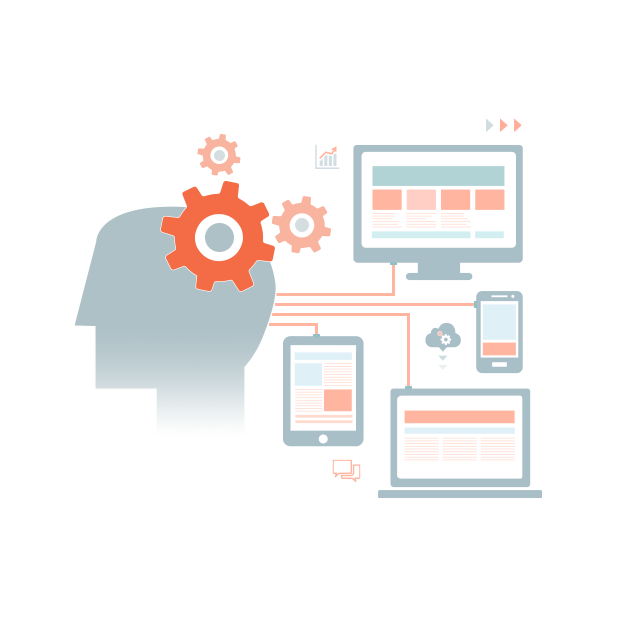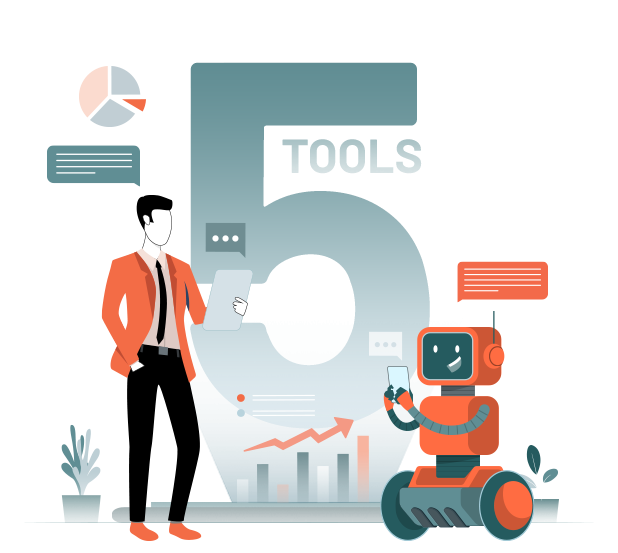Everybody wants to have their hands on Artificial Intelligence. The major step you need to take to integrate AI into your business is understanding the different AI models and handpicking the best one for your business. Here is a beginner’s guide on those models to get you started.
Let’s get started.
Popular AI models
Lets’s dig deeper into each and find the best AI model for you.
1. Linear Regression
Since it is straightforward to develop and easy to apply in real-time, linear regression is probably the first AI algorithm that one learns while beginning a career in machine or deep learning.
The link between a scalar answer (or dependent variable) and one or more explanatory variables (or independent variables), which may be continuous or categorical, is typically modeled using this data science and statistics technique.
Linear regression is often used in finance to model the relationship between a company’s stock price and various economic indicators.
For example, a bank might use linear regression to model the relationship between a company’s earnings and its stock price.
SaaS Founder Use Case
A SaaS company could use linear regression to analyze customer data and predict future revenue. For example, by analyzing the relationship between customer churn and various demographic factors, a SaaS company could create a model to predict which customers are at high risk of canceling their subscriptions.
2. Deep Neural Networks
Deep Neural Networks (DNN), one of the most well-known AI/ML deep learning models, is an Artificial Neural Network (ANN) with numerous (hidden) layers between the input and output layers. These share a similar foundation with the human brain’s neural network and are made up of interconnected components called artificial neurons.
Several fields, including speech recognition, picture recognition, and natural language processing, use DNN models.
They are also utilized for forecasting, machine translation, and many other tasks. Understanding DNNs as one of the most well-liked and frequently applied AI models is essential for grasping the fundamentals of machine learning.
Deep learning neural networks are used in various applications, such as image and speech recognition, natural language processing, and self-driving cars. For example, Google uses deep neural networks to improve image search results and facial recognition on photos.
SaaS Founder Use Case
A SaaS company could use deep neural networks to improve product recommendations and personalization features. For example, by analyzing customer browsing and purchase history, you could use a deep neural network to recommend products that interest individual customers.
3. Logistic Regression
Logistic regression, a well-known machine learning (ml) model, is the optimal solution for handling binary classification issues. It is a statistical model that uses the set of available independent factors to forecast the dependent variable’s class.
This is comparable to the linear regression model, except that it is only applied to situations involving categorization. Logistic regression will be our best choice if we’re attempting to forecast whether they will start smoking, depending on a person’s gender and age range.
However, linear regression would be more suited if we attempted to solve a problem with numerous classes, such as determining the type of phone (Android or iPhone) based on characteristics like screen size and battery life.
SaaS founder Use Case
A SaaS company could use logistic regression to predict which leads are most likely to convert into paying customers. For example, by analyzing the relationship between lead characteristics and conversion rates, a SaaS company could create a model to predict which leads are most likely to become paying customers.
4. Decision Trees
The Decision Tree (DT) model in artificial intelligence is used to draw a conclusion based on information from previous decisions.
A decision tree is a straightforward, effective, and widely used model, so named because the way the data is divided into smaller segments resembles the structure of a tree. Classification and regression problems can be solved easily with this model.
Don’t you hate it when important emails are lost in spam? When you’re a founder or a business owner, a mail you miss is a client you miss.
What if there’s a way to stop that?
SaaS Founder Use Case
Decision Trees could recognize features like the presence of attachments and the message’s word count to determine if an email is spam. As we’ve seen, there are numerous ways to use DTs for various applications.
5. Linear Discriminant Analysis
A subset of the logistic regression model is linear discriminant analysis or LDA. This method is typically employed when two or more classes must be separated in the output. This approach is helpful for various problems in the fields of computer vision, medicine, etc..
Using the features of the class determines the likelihood that an input belongs to that class. All potential classes’ probabilities are calculated, weighted, and then added together until they equal one.
SaaS Founder Use Case
Linear Discriminant Analysis (LDA) is used in face recognition. For example, a security system might use LDA to determine whether a person is authorized to enter a building based on their facial features.
6. Naive Bayes
Naive Bayes is a straightforward yet powerful AI model that can be used to address a variety of challenging issues. It is particularly used for test classification based on the Bayes Theorem.
The model operates under the presumption that the existence of one feature does not entail the existence of any other feature.
The model is called “naive” because this presumption is virtually never accurate. Both binary and multiple-class classifications can be done with it.
Spam filtering and medical data classification are a couple of its uses. In these circumstances, it picks up on the training data’s underlying patterns without being expressly coded.
SaaS Founder Use Case
A SaaS company could use Naive Bayes to improve its customer support and helpdesk service. For example, by analyzing customer support tickets and their associated resolutions, a SaaS company could use Naive Bayes to automatically classify and route new support tickets to the appropriate support agent.
.
7. Support Vector Machines
Support Vector Machine, or SVM, is a rapid and effective model that performs exceptionally well when processing small amounts of data. It works for issues involving binary classification.
SVM is quicker and more effective with a dataset of small samples than recent technologies like artificial neural networks, such as those used to solve text categorization problems.
This supervised machine learning approach applies to the classification, outlier detection, and regression issues. Maximizing the distance between the two classes, it determines the hyperplane that separates the two classes for classification tasks (in other words, by maximizing the margin).
Two sets of features are required to train this model: one for training (also known as positive examples) and one for testing (also known as negative examples).
Support Vector Machines (SVMs) are used in text classification, image classification, and bioinformatics. For example, SVMs might be used to classify images of handwritten digits.
SaaS Founder Use Case
A SaaS company could use Support Vector Machines (SVMs) to improve its fraud detection capabilities. For example, by analyzing customer transaction data, a SaaS company could use SVMs to find patterns indicative of fraudulent activity.
8. Learning Vector Quantization
Learning A sort of artificial neural network that operates on the winner-takes-all rule is called vector quantization (LVQ). It organizes data by creating a collection of codebook vectors that are then used to categorize additional invisible vectors.
It is applied to the resolution of multiclass classification issues. While vector quantization algorithms perform better when there are few classes and many features, classification algorithms function best when there are many classes and few characteristics.
They can be slower and require a bigger initial training set than other techniques, but they usually tend to be more accurate.
SaaS Founder Use Case
A SaaS company could use Learning Vector Quantization (LVQ) to improve its customer service chatbot capabilities. For example, by analyzing customer interactions with the chatbot, a SaaS company could use LVQ to improve the chatbot’s ability to understand and respond to customer inquiries.
9. K-nearest Neighbors
A straightforward supervised machine learning model called K-nearest Neighbors (kNN) can be utilized to solve classification and regression issues. This method assumes that related things (data) are located close to one another.
Although it is a strong model, one of its main drawbacks is that the speed decreases as the number of data increases. Additionally, the KNN model fares poorly when the dataset has many outliers.
Other limitations include inaccurate probability distribution estimation and poor handling of missing values.
SaaS Founder Use Case
You could use KNN to improve its customer segmentation and targeting capabilities. For example, by analyzing customer demographics, purchase history, and behavior, a SaaS company could use KNN to group similar customers and target them with personalized marketing campaigns.
10. Random Forest
A good ensemble learning model for both classification and regression issues is Random Forest. Multiple decision trees are used during operation, and the bagging approach generates the final forecast.
To make things easier, it creates a “forest” of various decision trees, each of which has been trained on various data subsets, and then combines the findings to get more precise predictions.
SaaS Founder Use Case
In light of this, this method can be applied to categorize consumer behavior by speculating what they could buy next based on past purchases. For instance, if someone bought bread this week and salad dressing last week, there’s a significant probability they’ll buy lettuce or tomatoes tomorrow as well.
Conclusion
Though there are many AI models, some are suited for statistical calculation, while others prove their worth in other areas.
How do you know which is the right one for you?
Choose your model based on your
- Resources.
- The time you can spend on a project.
- Your end goal.
However, the common problem is that people usually don’t have the high-level expertise to create and implement data analysis and Machine learning solutions.
Rather than going for a quick fix, choose the right experts to supercharge your productivity with AI/ML software. With over 100+ successful projects in the bag, our team is battle-ready & waiting for your call.




